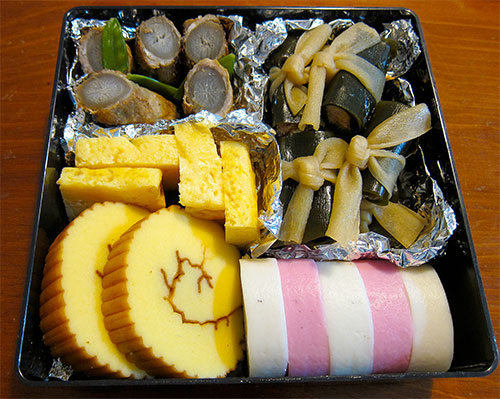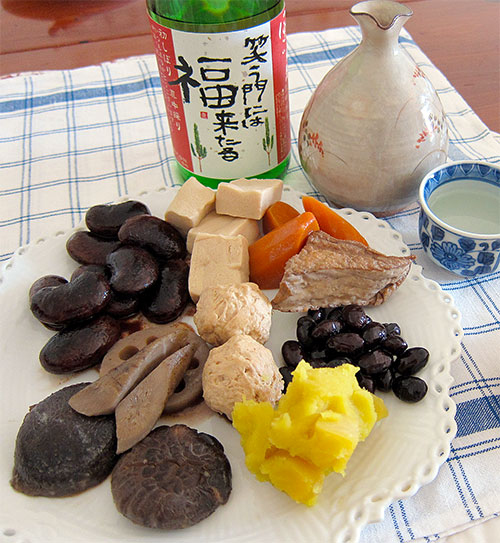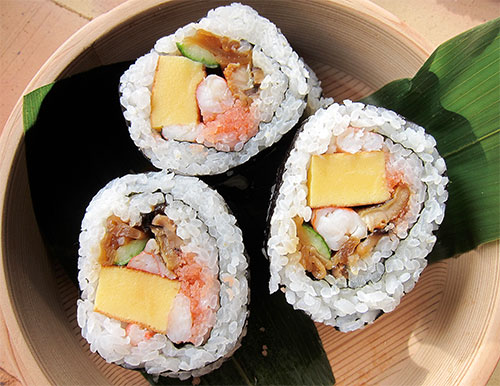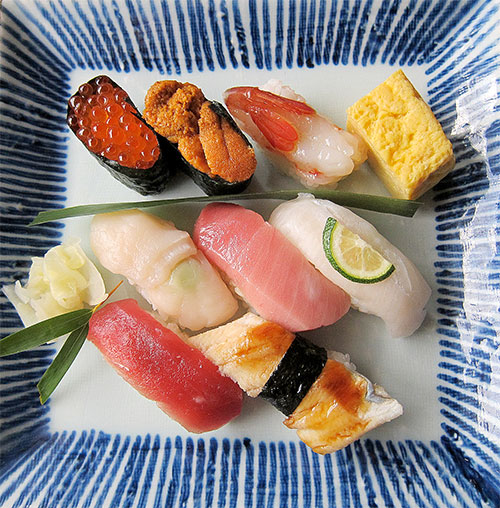Osechi (New Year's Feast): The Next Generation
I wasn't able to make it back to Japan to spend New Year's Day with my family, since I'm still not fully up to the enduring the rigors of a long flight by myself and The Guy is too busy with work to go away for an extended time. So my mother sent photos of the feast they had. I'm really sorry I missed it, since it marked the debut of the next generation of chefs in our family preparing food for an important holiday in a sense. In previous years my mother took the lead in making osechi ryouri (traditional New Year's food), but this year that role was taken on by my sister Mayumi and my 11 year old niece Lena. They started making everything 3 days beforehand and brought everything over to my mom and stepfather's place in juubako, which are large stacking bento boxes. Lena-chan was very much a little princess until just a year or so ago, but she's growing up so fast in so many ways it's amazing.
This is one layer of the juubako, containing onishime - a melange of winter vegetables, dried shiitake mushrooms, konnyaku and other items such as fried tofu and chicken simmered together in dashi. Lena-chan helped to prepare the vegetables and make the twisted konnyaku pieces. (For instructions for how to make the twisted konnyaku, see this page. For a simmered dish that's similar to onishime, see this recipe.) The golden brown things in the background are spring rolls, which are not exactly traditional for New Year's, but were pronounced as delicious by everyone. (Here is my recipe for Japanese style spring rolls.)

The next layer has a variety of things. Clockwise from top left: burdock root (gobo) wrapped in beef; kobumaki - semi-dried herring called mikaki nishin wrapped in konbu seaweed, tied with kampyo (dried gourd strips), and simmered; pink-and-white kamaboko; datemaki (egg and fish paste roll); and some slices of regular tamagoyaki. Mayumi and Lena-chan made it all except for the kamaboko and datemaki, which they bought.

They made even more osechi items, to eat during the New Year's holidays. Basically osechi items keep for several days, so you can take out a little at a time and enjoy them during the holiday period, so the cook of the family can take a little break from kitchen chores. On this plate, clockwise from top left there is boiled shrimp; nibuta (simmered pork - see my nibuta recipe here); some kind of simmered tofu (I don't have the recipe...I'll have to get it from Mayumi); simmered dried scallops; some 'chicken ham' (recipe for chicken ham or torihamu here); more datemaki; and two simmered satoimo or taro root (how to cook satoimo).

And here's even more osechi. Clockwise from top left theres some large kuromame (sweet black beans); a selection of simmered items from the onishime - kouya dofu or kohya dofu (or koya dofu) (freeze-dried tofu; see more about kouya dofu here), carrots and atsuage or deep fried tofu (more about atsuage and other types of tofu); another kind of kuromame using small black soy beans; kinton, or mashed sweet potatoes with syrup and chestnuts; and more onishime items - dried shiitake mushrooms, burdock root (gobo) and lotus root (renkon). In the center are two chicken dumplings or tsukune (recipe for tsukune here). In the background is a bottle of celebratory sake, an essential part of the whole feast of course. The label carries a saying: 笑う門には福来たる (warau mon ni wa fuku kitaru) - "Good luck comes to the gate (household) that laughs".

As if that weren't enough, they even made some futomaki or fat sushi rolls. Lena-chan was responsible for the actual rolling, and I think they look pretty great.

My mother and stepfather contributed a a plate of nigiri-zushi to the meal. Sushi is not at all traditional to the New Year, but more and more people are enjoying it these days.

I'm really sorry I couldn't make it there this year, but maybe I'll be there with the family in 2014, and to taste Lena-chan's osechi for myself.
In the meantime though I'm sort of glad that the holiday season is over. Maybe the workers will finally, finally finish up the construction work on the house so we can get to enjoy it fully without having to clean up the dust all the time and push back dropcloths to get at stuff. One can dream....^_^;
Happy New Year everyone!
If you enjoyed this article, please consider becoming my patron via Patreon. ^_^

 Welcome to Just Hungry, where we serve authentic Japanese recipes and more! I'm
Welcome to Just Hungry, where we serve authentic Japanese recipes and more! I'm 













Comments
anon.
3 January, 2013 - 19:46
Permalink
Re: Osechi (New Year's Feast): The Next Generation
Awesome! Thanks for sharing!
anon.
3 January, 2013 - 21:59
Permalink
Re: Osechi (New Year's Feast): The Next Generation
Glad you wrote about your family's osechi ryoori. Can you tell me what is in the futomakI? Whenever I make my nishime it gets overcooked. Any tips? where is the best place to get kuromame? Do you count the number of dishes present? Is osechi ryoori supposed to have boiled, fried, etc dishes like kaiseki? Can you reccomend a book that talks about new years foods, the symbolism, etc? Thank you!
maki
4 January, 2013 - 09:17
Permalink
Re: Osechi (New Year's Feast): The Next Generation
I don't know of a specific book that talks about the symbolism of osechi, but I wrote about some of in my most recent Japan Times article here, as well as in this post from a couple of years ago. Osechi is a bit different from kaiseki, since everything is supposed to keep for a few days (without refrigeration, but it's in January so people used to keep things in a cold area of the kitchen).
The key to nishime is to add things according to how long it takes them to cook, or to cook some things separately, then put it all together in the end.
ElaineSaunders
4 January, 2013 - 00:52
Permalink
Re: Osechi (New Year's Feast): The Next Generation
WOW WOW WOW
It will take me a year to try all these things out! But I guess some things will only be available at this time of year, so I will be off to Uwajimaya in the morning. Thanks and Happy New Year!
katnhwi
4 January, 2013 - 09:01
Permalink
osechi (new year's feast): the next generation
wishing you all the best for 2013!
Michelle Holtzclaw
4 January, 2013 - 16:40
Permalink
Re: Osechi (New Year's Feast): The Next Generation
Yum, yum, yum. I had this on New Year's, too. I'm the only who eats it (besides the Nisei), but my grandma makes it every year because I love it so. We call it nishime. Is that the same?
maki
4 January, 2013 - 18:42
Permalink
Re: Osechi (New Year's Feast): The Next Generation
For the stewed dish yes. Onishime (お煮しめ)is the honorific form of nishime (煮しめ) = the same thing.
Everbright
8 January, 2013 - 01:01
Permalink
Re: Osechi (New Year's Feast): The Next Generation
I would just about kill for a recipe for kinton that didn't start with "Buy a jar of preserved chestnuts." I mean, I realize that it's 100% easier if you can start with a canned chestnuts, but they're a little more difficult for me to chase down around the holidays than fresh ones for roasting. Maaaaaan, that stuff looks tasty!
Mariko Lane
15 January, 2013 - 00:26
Permalink
Re: Osechi (New Year's Feast): The Next Generation
I had fun reading this, especially since my mom was in Japan for New Year's and for the first time in a few years I wasn't. I realized that I would have to make Osechi myself if I wanted to eat it! I planned for days and it ended up turning out really well - I totally had to self-five myself. I used my Obachan's recipe for kinton and ozoni, and added my auntie's chicken karaage so my husband would have something more familiar to eat. I was able to get kuromame, ikura, kamaboko, and such at my local Japanese market. My husband and brother (who was also sad not to be in Japan for Shogatsu)and I were all able to ring in the new year together. Here's to a new start and a good year - I hope everything is now on the upswing for you!
Samuel Sands
30 January, 2013 - 19:51
Permalink
Re: Osechi (New Year's Feast): The Next Generation
My goodness the photos of these delicious dishes have my mouth watering. YUM!
Venetia
8 July, 2013 - 08:41
Permalink
Re: Osechi (New Year's Feast): The Next Generation
Do you have a recipe for karashi renkon? My late mother-in-law use to make this for Oshogatsu (Osechi) as well. Thank you.